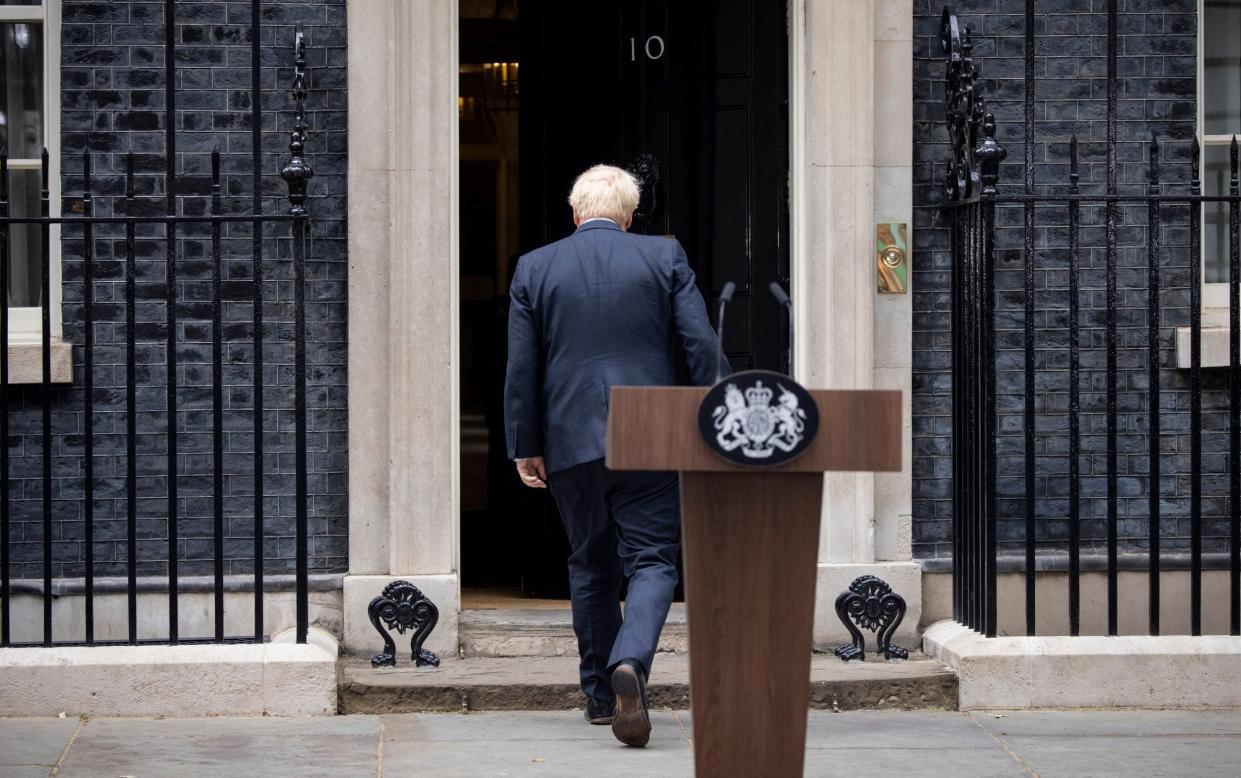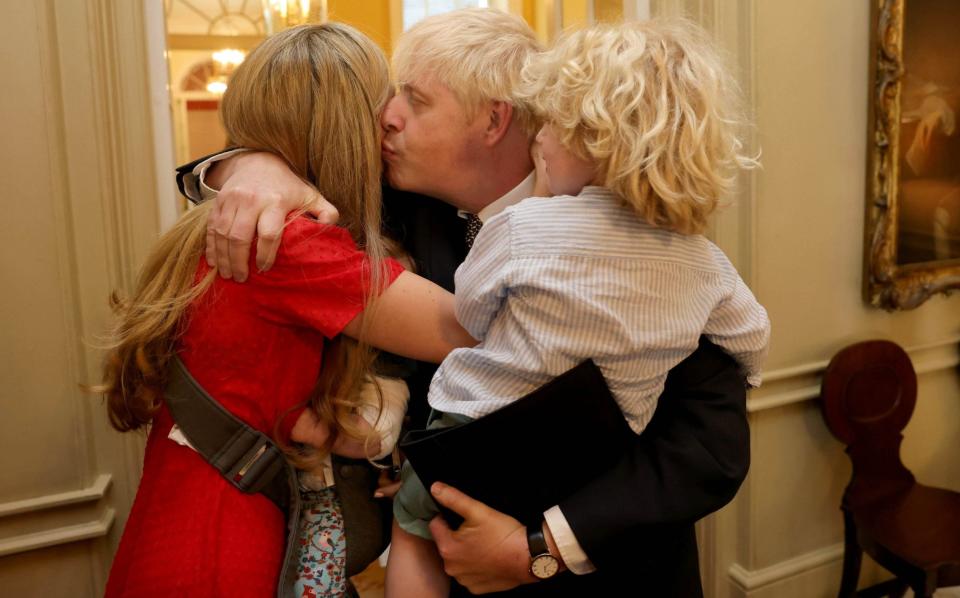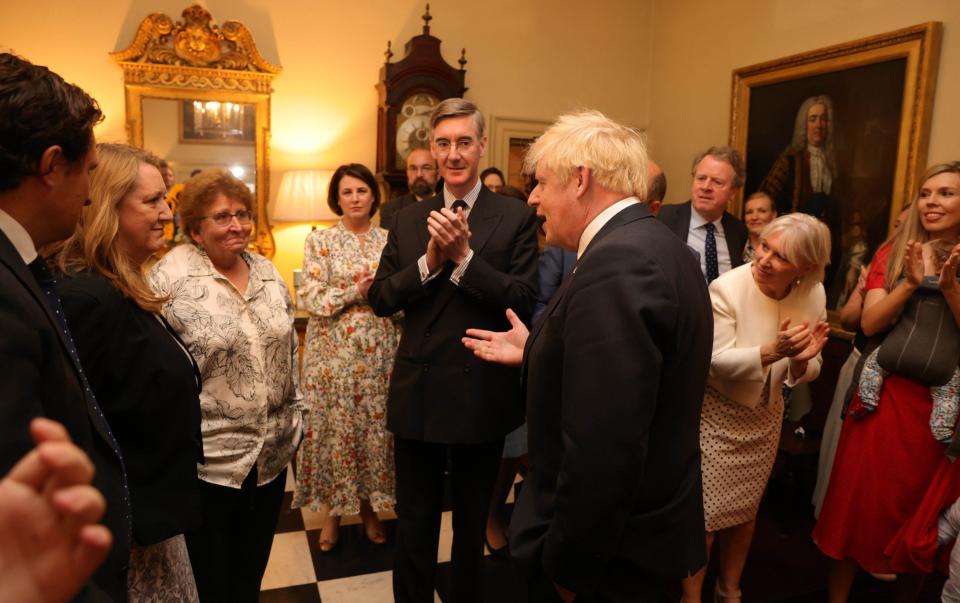The inside story of how Boris Johnson went from defiance to resignation overnight

- Oops!Something went wrong.Please try again later.
Boris Johnson had just announced to the nation that he would stand down from “the best job in the world”.
Back inside Number 10, the outgoing Prime Minister was met with a bear hug from his wife, Carrie, and their two children, Wilfred and Romy.
Downing Street took the unusual step of releasing images of the moment, with other pictures showing Jacob Rees-Mogg, Nadine Dorries and Alister Jack, loyal lieutenants, applauding as Mr Johnson stepped into the hallway.
Later, he would address his new Cabinet, joking that “in a hotly contested field, it’s the best Cabinet we’ve ever had”.
Responding to praise from frontbenchers, he made light of the idea he might be close to tears, telling them they needed to “plough on before I take out my onion”.


The decision to resign, which he had railed against less than 24 hours previously, was made at 6am.
According to those who talked to him in the early hours, there was a marked change in how he viewed his dire political situation after a night’s rest. One described it as “a moment of clarity”.
On Wednesday evening, the Prime Minister had been defiant. Cabinet ministers came and went, unable to persuade him to quit. There would, said aides, be no “lectern moment”.
But by dawn, he was working on his resignation speech.
“He is a fighter – his instinct was to have one last go at it, which he did,” said one ally who has been at Mr Johnson’s side throughout the last 48 hours and talked to him first thing.
“It didn’t work. He woke up this morning and realised the game was up.”
What changed his thinking? The political situation surely forced his hand – the resignations kept coming. It was becoming increasingly difficult for the Government to function.
Nadhim Zahawi, the Chancellor who had been appointed by Mr Johnson the day before, published a letter with a clear message for his boss. It said: “You must do the right thing and go now.”
If his inability to stem the flow of resignations wasn’t enough to push Mr Johnson over the edge, there had also been a moment away from the spotlight. The Prime Minister had a chance to take a breath and contemplate the life beyond politics that beckons with his wife and children.
A third factor may have been at play – The Telegraph can reveal that Mr Johnson talked to the Queen on Wednesday evening.
As speculation swirled about whether Her Majesty would sign off a snap election if one was sought, the Prime Minister and the monarch had a phone conversation.
The discussion was pre-arranged, part of the regular catch-ups that are a staple of Britain’s unwritten constitution. What was said remains unknown, but Mr Johnson would have been able to reflect on it overnight.
Whatever the ultimate trigger, the Prime Minister’s mind was set come Thursday morning. With much of the nation yet to wake, his most trusted lieutenants gathered in Downing Street to prepare his departure.
A “hearty tray of bacon sandwiches” was laid out for the assembled crowd, along with pots of black coffee.
Nigel Adams, the Cabinet Office minister who was there at the start when Mr Johnson launched his tilt at the Tory leadership in 2019, was said to be present. So too was Chris Heaton-Harris, the Chief Whip, who was urging the Prime Minister to realise that the game was up.
“I would describe his mood as sanguine,” said a loyal source in Downing Street on Thursday morning. “He’s good-natured, good-humoured. There is a sadness, there is a mild frustration that it’s come to this. He is very self-aware.”
The point at which Mr Johnson’s resignation became locked in was around 8.30am, when he called Sir Graham Brady, the long-serving 1922 Committee chairman who led the backbenches through the falls of both David Cameron and Theresa May.
The pair had talked in person in the Cabinet room on Wednesday evening as Sir Graham spelled out what was likely to happen if Mr Johnson did not go.
A new 1922 Committee executive would be voted in on Monday afternoon, he explained. The rules would then be changed to strip Mr Johnson of his year-long protection from another confidence vote.
Another vote of Tory MPs would soon follow, and in all likelihood Mr Johnson would lose. In other words, he would be unceremoniously dumped as the Tory leader.
Back then, the advice was dismissed. A Downing Street aide later told the press that Sir Graham’s position was full of “assumptions” and that he had not given the Prime Minister “a brandy and a gun”.
But the conversation on Thursday morning was very different. It was “civil”, with Mr Johnson’s change in position “obvious”, according to one source familiar with the discussion.
The Prime Minister’s mood was “quite calm” and “quite sober”. He explained that he had reflected on developments and would resign in the interests of the country.
They agreed that a new party leader would be in place by the October party conference, allowing time for a full Tory leadership race to be run and a successor picked by party members.
But critically, Sir Graham only agreed that a new prime minister should be in place in time for the conference – not that Mr Johnson could remain until that point.
The possibility that he would leave weeks before then was kept open by the 1922 Committee, despite Downing Street allies later suggesting otherwise in briefings.
The timings of how and when Mr Johnson would hand over power remained an open question, heatedly debated among Tory MPs all day. He alone cannot decide the timetable.
Next came a second call in 24 hours to the Queen. A discussion was not required – the Prime Minister was not leaving office on Thursday, and was not requesting a snap election. But he wanted to keep Her Majesty informed.
By then, two streams of work were in progress. One was on what Mr Johnson should say in his resignation speech, the other on how he could keep his Government – and his premiership – in place until October.
The first came largely from the Prime Minister’s hand. He wanted to both sum up what he had achieved while capturing a mix of sadness and the sense of obligation that led to his departure, according to aides.
The second had one most pressing demand – refilling the Cabinet. Downing Street aides had declared that new Cabinet ministers would be appointed on Wednesday night, only for no names to be announced by midnight.
Finding ministers who retained a degree of loyalty to the Prime Minister – even at this late stage – and were willing to serve in his Cabinet was the challenge. Those who said yes were announced from 11.30am.
James Cleverly, an old ally from Mr Johnson’s London mayor days, would be the Education Secretary – the third in 40 hours. Robert Buckland, sacked as the justice secretary in September, would return as Wales Secretary.
Greg Clark, a Cabinet minister under the May premiership and not a natural Johnson ally, would come in as Communities Secretary to replace the sacked Michael Gove. Less high-profile Tory MPs were drafted into other Cabinet roles.
The message Downing Street wanted to convey was that although Mr Johnson may be going, his Government is still functioning and can last until the autumn.
To that end, another phone call to Volodymyr Zelensky, the Ukrainian president – conversations so often timed just after moments of domestic political uncertainty for Mr Johnson – was scheduled for after the resignation speech.
“Hopefully the party gives him a tiny bit of space to help the country through the cost of living crisis. That is first and foremost on his mind,” said an ally.
The source’s tone was imploring, not demanding – an acceptance that how long Mr Johnson stays in Number 10 is now out of his hands.
As former colleagues scrambled to prepare leadership bids, with Liz Truss, the Foreign Secretary, returning from a G20 summit in Indonesia early, Mr Johnson was ready to tell the nation that he was calling time.
To the left of the Number 10 door were advisers, friends, Cabinet ministers and loyal MPs who had fought to keep him in place. Carrie Johnson looked on in a red dress, with seven-month old Romy strapped to her chest in a baby carrier.
A little down the street, to the right of the black door, a second group of MPs who remained on Mr Johnson’s side had gathered – just a tiny handful of the almost 360 Conservatives in the Commons.
Beyond the gates at the far end of Downing Street were protesters. A boombox blasted out Bye Bye Boris, an updated version of the Bay City Rollers hit Bye Bye Baby. Demonstrators gathered to heckle and boo.
Before Mr Johnson walked out to make his resignation speech, he took 10 minutes alone to compose his thoughts, according to an ally.
When he emerged in a grey suit and grey tie, striding towards a lectern bearing the official black government seal, his supporters whooped and applauded as protesters tried to drown the cheers with jeers.
The Prime Minister read from his prepared statement. There was sadness at leaving. There was frustration at the “herd” mentality that had seen colleagues turn so quickly on him.
There was acceptance, tinged with obvious annoyance. In a phrase only he could have selected to sum up the extraordinary disintegration of his premiership, Mr Johnson declared: “Them’s the breaks.”

